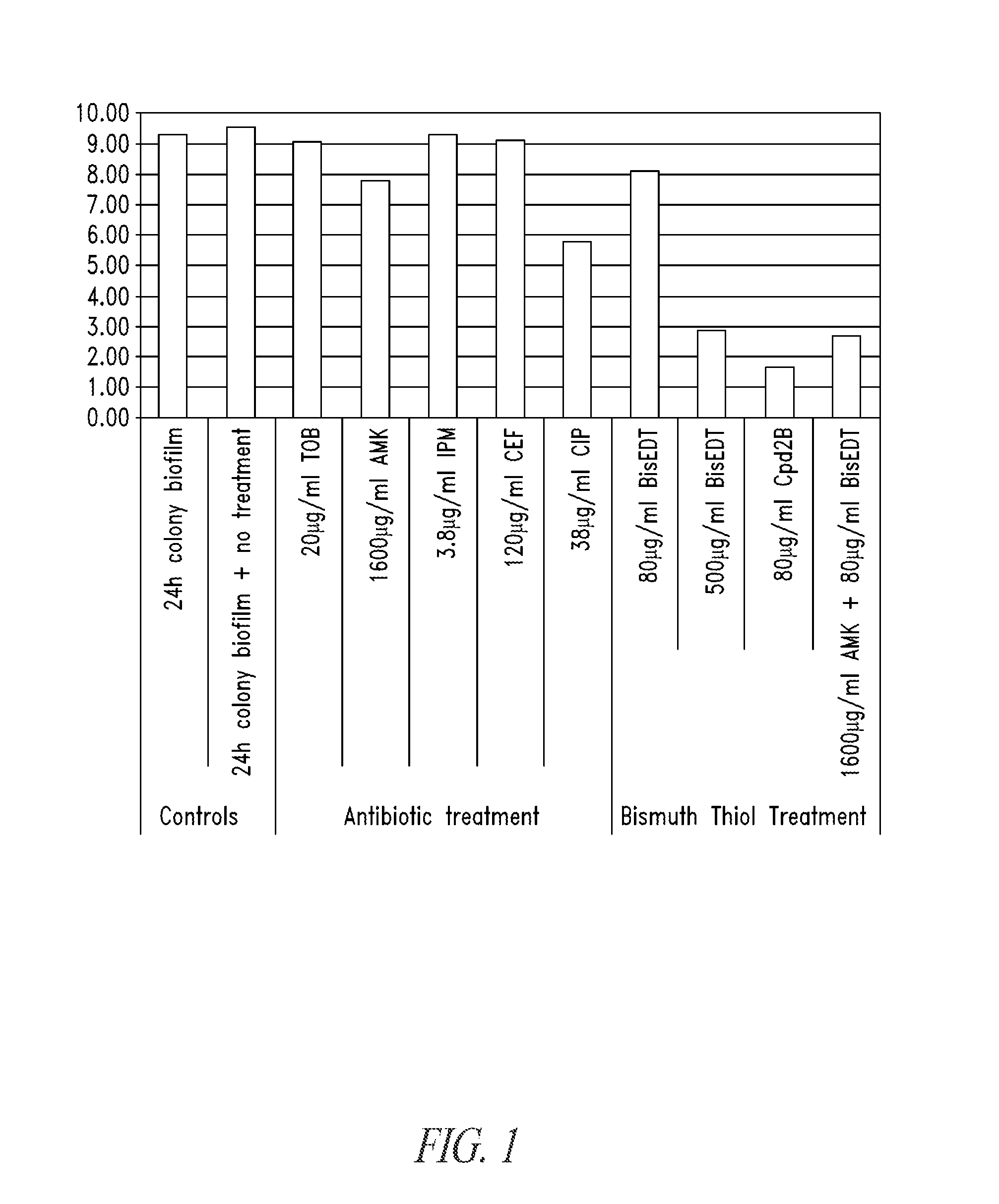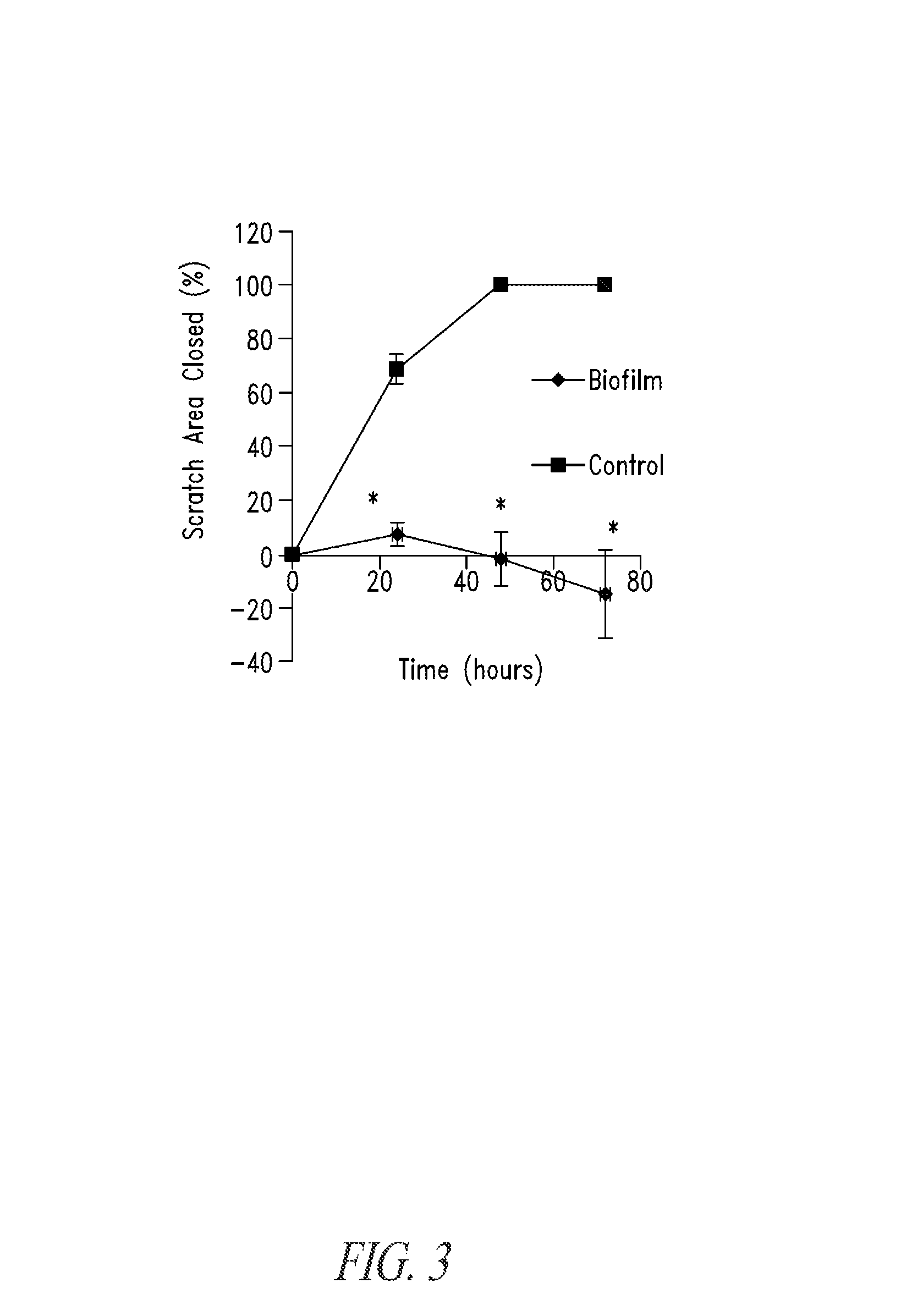Unfortunately, systemically or locally introduced
antibiotics are often not effective for the treatment of many chronic infections, and are generally not used unless an acute bacterial infection is present.
Current approaches include administration or application of
antibiotics, but such remedies may promote the advent of antibiotic-resistant bacterial strains and / or may be ineffective against bacterial biofilms.
There are many antiseptics widely in use, but bacterial populations or subpopulations that are established may not respond to these agents, or to any other currently available treatments.
Additionally, a number of antiseptics may be toxic to host cells at the concentrations that may be needed to be effective against an established bacterial infection, and hence such antiseptics are unsuitable.
This problem may be particularly acute in the case of efforts to clear infections from natural surfaces, including surface features on commercially and / or agriculturally important plants such as many
crop plants, and also including internal epithelial surfaces, such as respiratory (e.g.,
airway, nasopharyngeal and laryngeal paths, tracheal, pulmonary, bronchi, bronchioles, alveoli, etc.) or gastrointestinal (e.g., buccal, esophageal, gastric, intestinal, rectal, anal, etc.) tracts, or other epithelial surfaces.
Particularly problematic are infections composed of bacterial biofilms, a relatively recently recognized organization of
bacteria by which free, single-celled (“planktonic”)
bacteria assemble by intercellular adhesion into organized, multi-cellular communities (biofilms) having markedly different patterns of behavior,
gene expression, and susceptibility to environmental agents including antibiotics.
Recent research has shown that
open wounds can quickly become contaminated by biofilms.
Bismuth by itself may not be therapeutically useful and may exhibit certain inappropriate properties, and so may instead be typically administered by means of delivery with a complexing agent, carrier, and / or other vehicle, the most common example of which is Pepto Bismol®, in which
bismuth is combined (chelated) with subsalicylate.
Despite the availability of BT compounds for well over a decade, effective selection of appropriate BT compounds for particular infectious
disease indications has remained an elusive goal, where behavior of a particular BT against a particular
microorganism cannot be predicted, where synergistic activity of a particular BT and a particular antibiotic against a particular
microorganism cannot be predicted, where BT effects
in vitro may not always predict BT effects
in vivo, and where BT effects against planktonic (single-
cell) microbial populations may not be predictive of BT effects against microbial communities, such as
bacteria organized into a
biofilm.
Additionally, limitations in
solubility, tissue permeability,
bioavailability,
biodistribution and the like may in the cases of some BT compounds hinder the ability to deliver clinical benefit safely and effectively.
In
agriculture, every year billions of dollars of crops are lost due to the formation of biofilms.
The problem of anthracnose and biofilm-related diseases in plants is well known despite numerous unsatisfactory approaches that have attempted to address it.
Plant diseases also affect industries involved in transporting and preserving fruit, vegetables,
cut flowers and trees, and other
plant products, as the normal protective mechanisms employed by intact living plants are no longer operative in the harvested product.
These biofilms can cause many problems, including degradation of materials and clogging of pipes, in industrial and agricultural environments, and infection of surrounding tissue when occurring in a medical environment.
The medical field is particularly susceptible to problems caused by biofilm formation; implanted medical devices, catheters (urinary, venous,
dialysis, cardiac) and slow-
healing wounds are easily infiltrated by the
bacteria present in biofilms.
Biofilms also reduce the quality and product life of
cut flowers and trees.
Additional temporal and
spatial complexity arises as many microbes actively modify the colonized
plant environment.
When a plant is attacked by one of these microorganisms, the resulting damage provides an opportunity for additional microbial invasion of
plant tissue and it is the combined onslaught that ultimately damages and destroys the plant.
Plants that are under environmental stresses, such as drought or
poor nutrition, are particularly e susceptible to microbial
attack.
The widespread use of
chemical agents to control harmful plant pathogens can damage the balance of these beneficial fungi, and runs counter to the principals of organic management.
There are, however, other less welcome fungi, which
attack living plants and weaken or kill them.
Another category of microbial plant pathogens, viruses, may be resident within the cells of plant tissues and thus often cannot be treated with topically applied chemicals, such that affected plants must be destroyed.
There are currently no antibiotics specifically developed for the treatment of plants (although some antibiotics developed for other purposes have found uses on plants), leaving a number of economically significant
plant species vulnerable to pathogenic bacterial attacks.
For instance, fireblight infestations of numerous
plant species of the family
Rosaceae have proven untreatable.
Plants are also more susceptible to
disease if they are not growing under optimal or near-optimal conditions, for example, due to poor
soil quality (e.g., dearth of nutrients) by itself or in combination with drought or excessive rainfall or flooding.
Conversely, biofilms on seeds and sprouts used for human consumption are often common sources of gastrointestinal infection.
Fett et al. found that both
Escherichia coli O157:H7 and
Salmonella populations on alfalfa sprouts required treatments much harsher than simple
water washing to reduce the numbers of adherent microbes, and full removal was never achieved.
Cutting flowers or trees is a similar type of wounding that is especially prone to vascular infection.
Biofilm bacteria enter and clog the vasculature at the
cut surface, and interfere with the flow of water, minerals and nutrients.
The consequence of a
pathogen becoming endemic can be serious, in some cases having an
impact on the national economy.
The emergence of
streptomycin-resistant (SmR) plant pathogens has complicated the control of bacterial diseases of plants.
Indeed,
bacterial disease management in most
cropping systems is based on the integration of genetic resistance of the host,
sanitation (avoidance or removal of inoculum), and cultural practices that create an environment unfavorable for
disease development.
Although liquid dispersions may be safely used at the site of preparing end-use resin compositions, careless use or disposal of the liquids may still
pose environmental and health hazards.
However, every known derivative compound is highly toxic to animals and fishes, which significantly restricts their application.
The need of the host to bind and possibly sequester the
metal during
pathogenesis is another central issue.
Oxidizing brominated and chlorinated compounds, for example, are highly toxic and corrosive.
It is chemically incompatible, however, with paints that rely on
metal carboxylate curing agents.
Particularly problematic in
agriculture are infections composed of bacterial biofilms, a relatively recently recognized organization of bacteria by which free, single-celled (“planktonic”) bacteria assemble by intercellular adhesion into organized, multi-cellular communities (biofilms) having markedly different patterns of behavior,
gene expression, and susceptibility to environmental agents including antibiotics.
Recent research has shown that
open wounds can quickly become contaminated by biofilms.
These
microbial biofilms are thought to impair growth, development and / or
wound healing, and are very likely related to the establishment of serious and often intractable infections.
 Login to View More
Login to View More 


